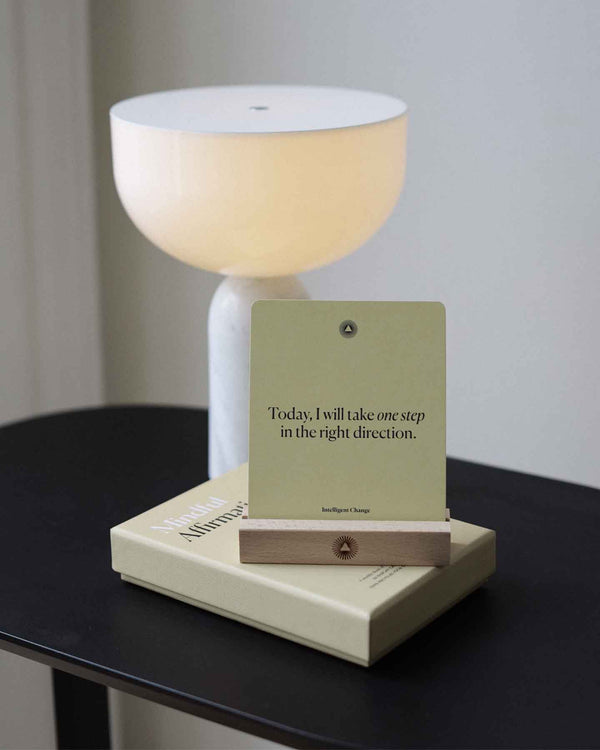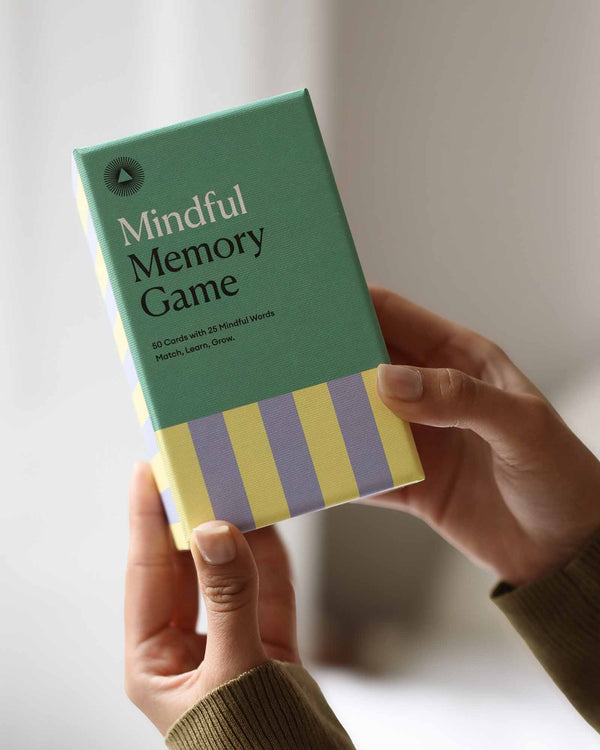Five Minute Journal Tips
by Kevin Evans
Below you will find 10 tips to get the most out of The Five Minute Journal including best practices and ways to avoid getting stuck.
CONTENTS
1. The Most Important Tip for Sticking With The Five Minute Journal2. Get Specific!!!
3. Breaking the Rules of The Five Minute Journal
4. Using Categories: How Tim Ferriss Uses The Five Minute Journal
5. This is How You Really Make Your Day Great
6. How to Write Effective Affirmations
7. How to Do an Amazing Review of the Day
8. Using The Five Minute Journal to Learn & Improve Every Day
9. Modifying The Five Minute Journal
10. Why Do You Use The Five Minute Journal
TIP #1: The Most Important Tip for Sticking With The Five Minute Journal
It may seem simple but...
To build the habit of using the Five Minute Journal consistently, the most important decision you can make is where you choose to keep the journal (and a pen).
Choose to keep it somewhere you are very likely to see it (near the bed, near the toothbrush, etc) morning and night.
If you’re using the App, it’s best to use reminders. Turn them on now! This will make all the difference. Done? Good. If not, what are you waiting for?

One of our users, Liz, finds that the only way she’s able to do the journal is if she keeps it on her bedside table. If she keeps it farther away from the bed, she is shocked to realize she hasn't practiced journaling in over a week just because of the location.
Within our team, Kevin reported doing the Five Minute Journal less frequently or forgetting to do it simply by not having it within arms reach upon waking. If the Five Minute Journal was on his desk across the room, it rarely got done.
Again, this tip may seem overly simple, but we find most people who report forgetting to do the Five Minute Journal did not consistently practice this tip.
Do it now (or as soon as you’re able) - keep your journal with a pen somewhere it’s impossible to miss in the morning & night. Reduce your mental barriers to adopting this positive life changing habit. You’ll be glad you did. That’s it.
Quick question: Where do you keep your journal? Share here.
TIP #2: Get Specific!!!
We have heard from numerous Five Minute Journalers that, at times, it can feel repetitive. People get tired of writing the same old stuff they are grateful for each day. What to do?!
We say,

When doing the Five Minute Journal it matters less what you write; it matters more what you experience and feel.
Thinking of a list of things to be grateful for usually comes rapidly, but the feeling typically takes a bit longer to kick in. Waiting for the emotion--the wonder and awe--before putting pen to paper makes all the difference.
The more detailed you can get while writing what you are grateful for, the easier it is to connect with the emotion.
Think about novels. Typically, authors do not just generally describe something, they get into detail. Novelists do not just say, “he drove a car,” they say, “he drove a black Mustang that sounded like it held a grudge".
For example, today you write, “I am grateful for John.”
Do you actually feel good writing that down? If not, get specific. What is it about John that makes you grateful?

Do the same with the "3 Amazing things that happened today..." section:
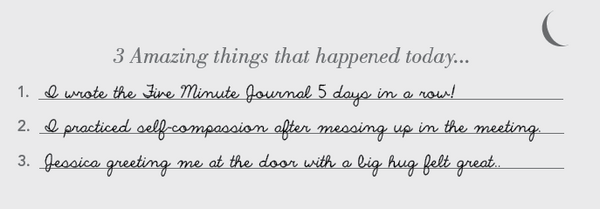
Now pause for a moment. How do you feel with what you wrote down? Are you connecting with it? If not, try writing something new until you do. If you connect with it, then congratulations! It’s time to move on.
If you do not rush through writing your gratitudes and take a few extra moments to dig deeper, you will see much greater and lasting results. The more you practice this, the easier and quicker this process will become.
TIP #3: Breaking the Rules of The Five Minute Journal
When thinking of things to be grateful for, many people think they need to come up with a grocery list of gratitudes. Often this produces repetitive, disconnected feelings. Gratitude gets processed in the head and not the heart. #OHSNAP
In our last tip, we shared how getting specific with what you write down massively helps you connect with the feeling. And on some days, this requires extra writing room.
While the Five Minute Journal “I am grateful for” section is numbered, many days I simply scratch out the numbers:
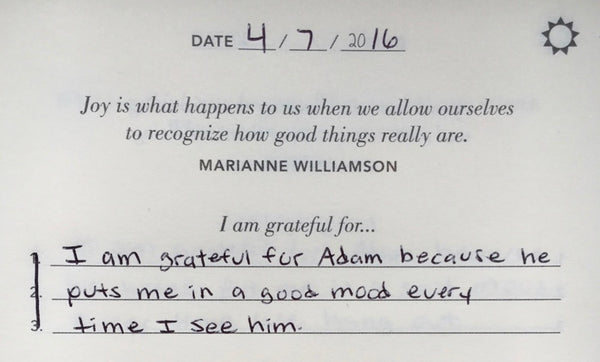
You can do the same for reflecting on your day…
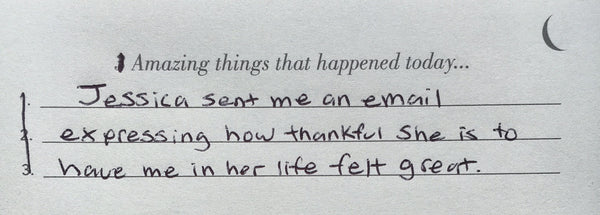
The important question to keep in mind here is: Do I connect with what I write down? If you write 3 gratitudes each day, great! If not, take more room to write. Also great! Over time, you will strike a balance that feels right to you.
The Five Minute Journal is your time capsule of positive memories for years to come. Make it work for you!
TIP #4: Using Categories: How Tim Ferriss Uses The Five Minute Journal
In previous tips, we talked about the importance of connecting with what you write down in the Five Minute Journal. No connection/feeling to what you are grateful for = no bueno.
Despite knowing this tip and having the best intentions to write soul fulfilling gratitudes, you will inevitably face “gratitude block.” From here you have a choice. Either quickly write a meaningless gratitude (world peace!), take longer to write so you connect (but I have to get out the door for work!) or option 3.
What is option 3 you ask?
It’s how Tim Ferriss (best-selling author of the 4 Hour Work Week, 4 Hour Chef and 4 Hour Body) uses the journal. He’s a type-A personality who finds the Five Minute Journal quite useful to practice gratitude and start the day on the right note.
So how does Tim use the Five Minute Journal?
Instead of thinking of random gratitudes each day, Tim single tasks the Five Minute Journal a la categories.
Tim uses 4 categories:
1. Relationships: An old relationship that really helped you
2. An opportunity that you have today
3. Something great that happened or your saw yesterday
4. Something simple near you (clouds outside, pen you are holding, etc)
Instead of trying to color with every gratitude crayon in the box, he uses a few. What if today you just focused on relationships you are grateful for? Or things you are grateful for about your health? Or all the ways you can be grateful for mini pigs?
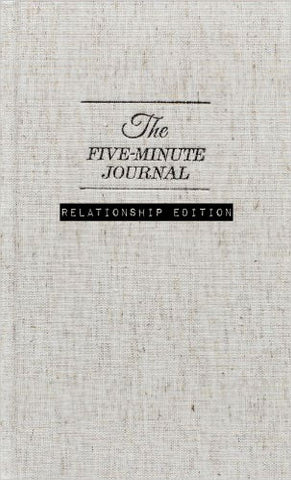
I currently have a personal goal of wanting to improve my relationships. What if I dedicated my Five Minute Journal solely to this purpose? It could look like this:
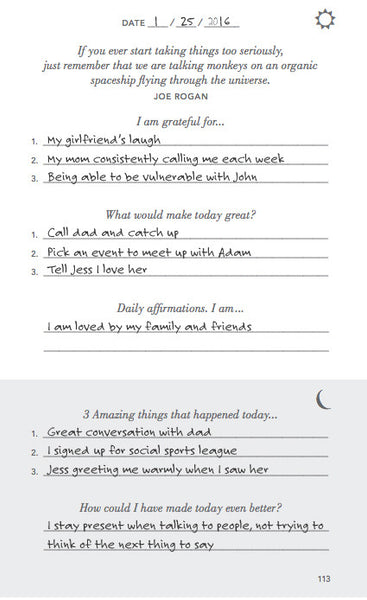
I usually find that having a day where I select a "category" to focus on helps generate gratitude ideas quicker. Thanks Tim!
If you get stuck in the Five Minute Journal, pick one singular focus and use the Five Minute Journal solely dedicated for that day, week, or month.
TIP #5: This is How You Really Make Your Day Great
When great things happen unexpectedly during the day, month, or year it’s easy to feel…great. It could be a friend writing you a thank you letter, winning tickets to a concert, or finding twenty dollars in your jacket. Feels pretty darn good!
A problem arises if you expect random great things to happen in order to make your day great and they never come:

You can, however, focus on taking tiny daily actions that increases the likelihood of making your day great.

How many times prior to doing the Five Minute Journal have you asked yourself, “what would make today great?” Imagine creating a consistent “cycle of great things” like this:

It’s like a chain reaction:
- Focus on smiling more → more people being warm and friendly too you → more friendships randomly appear.
- Focus on going to gym → become more attractive to opposite sex → more dating opportunities randomly appear. Focus on meditating → become more calm → more patient people randomly appear.
Of course, the process is not linear, but in general, the more action you take towards making your day great, the greater likelihood random great things appear. In sociology, they call this the Matthew Effect (or accumulated advantage), the phenomenon where "the rich get richer and the poor get poorer."
So how do you actually make your day great?
Do you know that spent, fulfilled feeling you get when you finish an amazing day? Aim for this. If it helps, close your eyes and project yourself to the end of the day, imagining and visualizing the things that would have happened if you were feeling that feeling.


These actions do not need to be earth shattering. The key is to keep them tiny enough so you actually complete them. They can be as simple as “tell my wife I love her”, “get outside today,” or “smile at the barista today.”
When first filling out this question, you may write a bunch of action items that you thought would lead to satisfying day, but in reality did not. That’s ok! Over time you will get better at identifying the things that make your day great and thus answering this question becomes much easier. Your progression will look a bit like this:
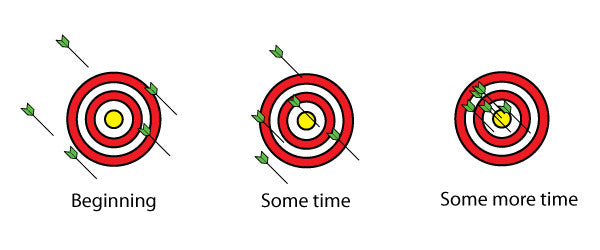
If thinking of 3 great things each day seems overwhelming, focus on ONE thing for the day--one thing that if completed would leave you satisfied with your day. Quality trumps quantity here.
What if the "what would make today great" section gets repetitive or you consistently fail to do any of the items you write down?
If I am building a new habit (such as meditating, starting a new workout, developing new social skills), odds are I will have the same action items several days/weeks in a row. As long as I keep feeling fulfilled from completing that task at the end of the day, it stays. If it begins to feel empty and meaningless, I reassess what I write down.
As Leonardo Da Vinci said, “A well spent day brings happy sleep.” Now go and make your day great!
TIP #6: How to Write Effective Affirmations
I have learned writing daily affirmations is probably the most misunderstood part of The Five Minute Journal.
There is more to affirmations than wishing for a million dollars and hoping the universe will magically deliver it to you. So we need to get the basic principles straight.
First, I will talk about the foundation and purpose of this section before moving on to some tactics.
THE PURPOSE: Work at the edge of your reality
Let us understand this by an illustration:
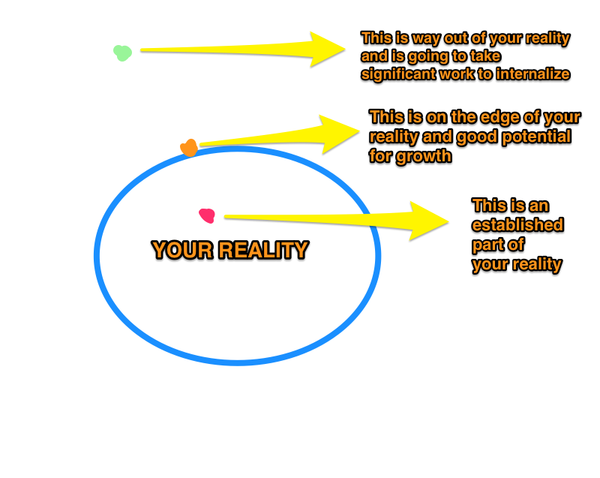
Let’s take an example of an eager Five Minute Journaler. Meet Cole.
Cole is an entrepreneur who started a couple of successful product-based businesses.
If he were to write the affirmation, “I am excited to create great products that help people”, that is very much in his current reality (the pink dot).
If he were to write the affirmation, “I am pumped to grow my businesses by 50% this year”, that might be at the edge of his current reality (the orange dot).
If he were to write the affirmation, “I am honoured to be the industry leader in sustainable growth products”, that would be significantly outside his current reality (the green dot).
In general, the purpose of an affirmation is to push the edges of your reality. You want it to be around the orange zone. If you are comfortable stretching the edges of your reality significantly, then go green.
The litmus test of how good your affirmation is depends on how do you feel after you write it.
Do you believe it? Do you feel better? If so, you’re on the right track.
Do you feel worse? Chances are you’re biting off more than you can chew.
Do you feel neutral? Chances are you’re not thinking big enough.
From here, there are two tactical ways to write affirmations.
THE TACTICS: The Hammer and the Butterfly Approach
1. The Hammer Approach - This is where you pick an affirmation that you want to deeply integrate into your life and you write it in your journal every day. The more often you write it, the deeper you integrate the strength of that belief within yourself. I find this technique works well for me.
We call it the hammer approach because you basically hammer in one affirmation until you truly experience the benefits and it has become part of your life.
For example:

2. The Butterfly Approach - This is where you make up your affirmation on a daily basis. You affirm a part of your reality you want to see more of - maybe you have a presentation later in the day and you want to write this:

Basically, you let your feelings that day or what you have planned to guide your affirmations.
Whatever approach you choose can work well and I recommend picking one and sticking to it.
In summary, choose an affirmation that is at the edge of your current reality and then use either the Hammer or Butterfly Approach to write in your affirmation. Remember, the litmus test is how you feel as you write your affirmation as a compass for progress.
How do you feel about affirmations? Share here with this quick 10-second multiple choice question.
TIP #7: How to Do an Amazing Review of the Day
Every night when I open my Five Minute Journal I see this question:

Here’s the thing. If the day was incredible, the section will write itself.
But if the day sucked, you might feel conflicted when you hit this question. The aim of this email is to resolve that conflict. Let’s take an example.
Say Alice finishes a sub-par day with many distractions at work, traffic delays, and a cancelled meeting she was looking forward to.
What is she going to write in her Five Minute Journal!?

As entrepreneur and motivational speaker Jim Rohn said, “Don’t wish it were easier, wish you were better.”
The important thing to understand here is that ‘amazing’ does not necessarily mean buying your dream house or finding your life partner.
It can also mean that the stoplight turned green at just the right time or the barista flashed you a wonderful smile. If you truly look for it, you will find amazing moments in your day. Sometimes an amazing moment can be avoiding a problem or conflict. That too is a success. The “things could have been a whole lot worse” scenario.
When Alice first looks at the “3 Amazing things that happened today…” question, she first thinks, ”Nothing amazing happened today”. That is just the first layer of the mental response. She knows that there are more layers and all she needs is a little more time to get to dig a little deeper and get to the good stuff.
Alice starts to review her day from the moment she woke up, looking for nuggets of amazing moments. It takes her some time, but she remembers three wonderful moments and jots them down:

The critical factor here is connecting with what you write down. As per a previous 5MJ tip email, the more specific you get, the easier it will be to connect with the emotion. Keep going with finding the amazing moments and you will find some great ones.
TIP #8: Using The Five Minute Journal to Learn & Improve Every Day
When you read the following question:

Do you think:
(A) “Reflecting on how I could have made each day better gives me a chance to learn, grow, and evolve. Bring it on!”
(B) “Reflecting on how I could have made each day better makes me feel bad about what I accomplished or did NOT accomplish, during the day. Ughh!”
Unfortunately, many Five Minute Journalers have wrote in and identified with the thought expressed in (B). In other words, many of you have been ending the day with feelings of inferiority and shame. Let’s resolve this!
For starters, if you have an great day, it is perfectly ok to write nothing in this section. Put a smiley face here and move on with your day.

For the other times, I will talk about the foundation and purpose of this section before moving on to some tactics.
THE CORE BELIEF
When Adam the Achiever approaches a goal, he has an underlying belief to one day be “done.”
- Once he gets six pack abs, he will accept his body.
- Once he makes a million dollars, he will finally be happy.
- And once he gets a long term partner, he will finally love himself.
Many of these beliefs render Adam completely overwhelmed and he winds up not making much progress on any of these goals. Fundamentally, his identity is rooted in his results, which always seem out of reach.
When Adam the Achiever fills out the ‘How could I make today better section’, he thinks, “There is so much I did not do. I am a even bigger loser than I thought.”
When Gigi the Grower approaches a goal, she has the underlying belief that she is a work in progress.
She thinks she is not sure if she will have the perfect body, but if she keeps eating vegetables, clean meats, and exercising, she puts herself in a position to be healthy. Gigi knows she will never be "done" and is happy that she makes some daily progress.
When Gigi the Grower fills out the ‘How could I make today better section’, she thinks, “Huh, there are bunch of things I could have done. I will have to try them out.”
Adam thinks he is bad and fundamentally flawed and wants to fix himself. Gigi knows she has flaws, but fundamentally believes she is making progress and greatness is within her grasp.
Gigi’s mindset will yield way more success than Adam’s defeatist thoughts.
Cue the platitude:

This is the core belief to have while filling out this section.
You are not trying to create a perfect you or a perfect day. This section is simply a reminder that you have the power to change your perceptions of the past and influence the future.
This begins by accepting yourself as a good person who makes mistakes and learns and grows through time.
Ironically, a great place to start if you have feelings of shame and inferiority while filling out this section is to write, “I will view myself as a work in progress.”
THE TACTICS
From a tactical perspective, the whole point of the “How could I have made today better” section is to identify patterns of persistent problems and then write actions to move past them.
For example, let’s say today you spent all day inside and felt bad about not socializing. In “How could I have made today better” you could have filled out:

I am not sure if you remember the instructions in the beginning of the Journal. This is where most people stumble. The sentence needs to be kind of like an affirmation for doing the right action the next time around.
Let’s take that statement and change it into this:

These are specific actions you can take tomorrow that will noticeably shift you into socializing more and get the result you are looking to achieve.
Another example...
You really wanted to go to the gym today and exercise, but you did not make it. You may write.

Let’s say the next day you still do not make it to the gym. Now you are starting to feel bad about yourself. No worries, this is a hint to scale back your ambition and be realistic. Maybe planning to hit the gym 3 times/week is realistic. Focus on what works.

Do not write unattainable/unrealistic goals that when you do not meet them, make you feel bad.
The litmus test is that once you finish writing this, do you feel good? If it does not resonate, take this as a sign to step back and do some reassessing.
Again, if you had a great day, it’s perfectly ok to draw a beautiful smiley face to end the day.
Quick question: What do you typically write for the “how could I have made today even better” section? Share here.
TIP #9: Modifying The Five Minute Journal
Time to color outside the lines!
Filling in the Five Minute Journal can get repetitive. There are some days where I just go through the motions and think “ehh I have to fill this thing out again”.
And out of this boredom, an idea was born. Necessity is truly the mother of invention:
What if I messed with the Five Minute Journal structure?
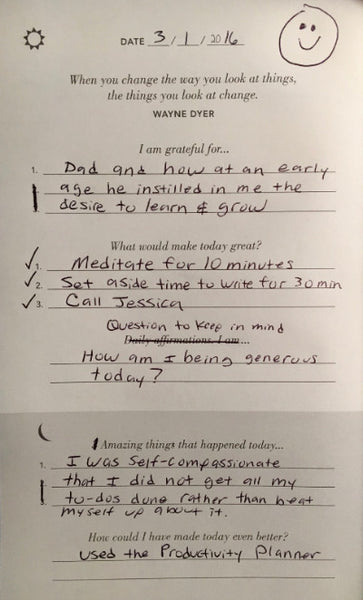
To begin, instead of writing three things I was grateful for on March 1st, I only wrote one thing, but wrote in greater detail. It is not about the quantity, but QUALITY. The journal should not be seen as a school exam where you have to ensure you fill in the blanks.

I then wrote out my list of what would make today great. At the end of each day I will go back and check mark each task I got done. This helps keep me accountable.

Then for daily affirmations, I decided to modify this to a daily question to keep in mind:

As I ended the day, I did the same thing for the night section as the morning. I wrote in greater detail about one amazing thing that happened instead of three:

For the last question, I decided to keep the format the same, plus a little shameless endorsement :)

And finally, I have begun marking days as unhappy, neutral, and happy in the upper corner as a general indicator of how I felt that day:
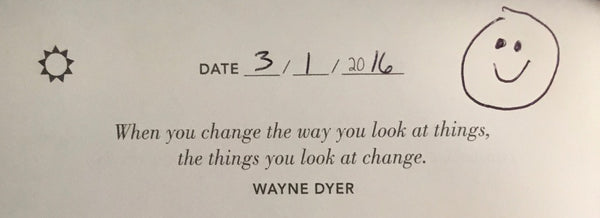
Most days I stick to the structure of the Five Minute Journal and don’t change a thing, but sometimes I will want to make a modification here or there. Maybe I only feel like writing one thing I’m grateful for in more depth. Maybe instead of writing how would I make today great I write, “How would I make today more fun?”
At the end of the day, the Five Minute Journal is a tool. Utilize it for your own needs. Be creative. And above all. Have fun!
Have you modified your Five Minute Journal? If so, share on instagram or facebook using #fiveminutejournal
TIP #10: Why Do You Use The Five Minute Journal
Gym owners love January 1st. That is when SO many people come, pay for the year, and never set foot back in the place. Ever.
Replace the gym with practically any new behavior change--learning a new language, meditating, or learning an instrument. People get all excited in the beginning, but somewhere along the way, enthusiasm fades and the exciting new hobby is dropped.
We do not want that to happen to you with the Five Minute Journal!
In the beginning of the Five Minute Journal we ask you to write why the habit is important to you. The section is short and only gets three lines but quite frankly it is the most important section.
Do you want to become more grateful? Why?
Do you want to become happier? Why?
Do you want to become more positive? Why?
Getting clear on your "why" will make all the difference.
It is the fuel that keeps up the Five Minute Journal habit when times get tough and you do not feel like doing it. Think of the gym again. You drag yourself there after a long day but feel amazing after.
Let us compare and contrast:
- A: The Five Minute Minute Journal is important to me because I want to be more grateful.
- B: The Five Minute Journal is important to me because it allows me to be more present, loving, accepting with my family, and show up as a father.
With B, we can feel the reason. We can see the reason. We believe the reason. It is clear.
Another fine example:
- A: The Five Minute Journal is important to me because I want to be happy.
- B: The Five Minute Journal is important to me because I want to make the best out of the cards I was dealt in life. I want to celebrate life and live with joy rather than seeing the world with a cynical, glass-half-empty attitude like the environment I grew up in.
With B, we can feel the deep seeded beliefs and emotions associated with being unhappy. It is much more meaningful than a vague “I want to be happy.”

If you do not actually believe the Five Minute Journal can change your life, it will not. It will just be another project that sits on the shelf collecting dust. Become engaged. Positive change awaits you if you make the effort.
So we would like to know, why do you use your Five Minute Journal? Take a minute to share here.







